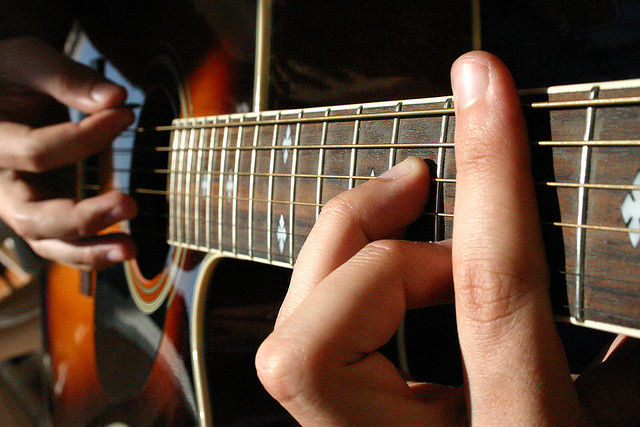Beyond the Fretboard: Visualizing Your Own Scales, Part 1

As guitar players, we sometimes get too comfortable with certain scale shapes because they can be easy to remember.
For example, think about the minor pentatonic scale; almost immediately, the mental image of that familiar box shape is probably conjured in your mind's eye. The fact that we can instantly recall various patterns due to their spacial layout over the fretboard is a great thing. But what if we're relying too heavily on existing scale shapes?
Scales are just pre-determined paths that get us from point A (root note) to point B (the octave). Some scales sound very musical, while others have a less-conventional harmonic architecture.
For some younger rock guitarists, the process of learning and memorizing existing scales might be the extent of their development when it comes to improvising.
But what about arpeggios? Arpeggios seem to be an intimidating concept to beginners, intermediates and even some advanced players for a few reasons:
01. The name seems "elitist" in nature and sounds like it should be reserved for classical music.
It simply comes from the italian word "arpeggiare," which either translates to "play on a harp" or "broken chord." All this means is we're playing each note of a chord separately, without any of the notes ringing out simultaneously. On a theoretical level, arpeggios and chords are basically the same thing. The only difference is in their execution; one is monophonic (one note at a time), while the other is polyphonic (multiple notes at the same time).
All the latest guitar news, interviews, lessons, reviews, deals and more, direct to your inbox!
02. Arpeggios are viewed as being "synonymous with sweep picking."
Not everyone wants to be a shredder. For this reason, some people tend to underestimate or even completely ignore arpeggios because they have been popularly linked with sweep picking. Yes, a lot of technically advanced axe-slingers love using arpeggios. But truth be told, you NEVER have to learn sweep picking in order to effectively use arpeggios.
03. Some of the more popular arpeggio shapes seem difficult to play and memorize.
Since arpeggios are 'broken chord' patterns, they're usually laid out over the fretboard in familiar chord shapes (derived from the CAGE system). But this brings us back to the previous problem. After all, the most economical way to execute a "C shape" minor arpeggio would be to sweep pick it (because that shape consists of a one-note-per-string sequence).
So what's the best way to make arpeggios accessible to ALL guitarists? One way is to visualize them as if they are scales (the only difference is that they consist of chord tones).
That sounds reasonable, but there are a few practical limitations to this proposal. First, the most basic arpeggio (triad) is comprised of a meager 3-note grouping. This makes it rather difficult to plot the notes on the fretboard in a 'boxed' format without invoking the sweep picking approach.

As you can see, it's doable but challenging if you're not used to a wide shape, which involves tough hand stretching and some tricky finger rolling. But if you're up to the task, these patterns can definitely be useful.
Let's try adding an additional note to the mix. The most obvious way to do this would be to experiment with 7th arpeggios (or 7th chords). These chords definitely have a unique harmonic texture that distinguishes itself from the more conventional-sounding triads.
The quick theoretical explanation as to why they're called "7th chords" is pretty straightforward; both the major and minor scales each contain seven notes. Triads are simply the first, third and fifth notes of a particular scale played together (becoming a chord) or individually (becoming an arpeggio). If we add the seventh note in a scale to the existing triad, we arrive at a 7th chord (essentially, all of the odd-numbered notes in a 7-note scale played simultaneously; 1,3,5,7).
So let's see how these guys help in our quest of creating visually friendly shapes on the fretboard without resorting to sweep picking.

(Note: the numbers inside the circles are suggestions for which fingers to use for each note. These are just suggestions, so feel free to use alternate fingering schemes and even slides in some instances)
Not bad, but there's still some stretching involved and the shapes are a little too abstract. But at least we've started to look at arpeggios in a two-note-per-string context. Hopefully this is helpful for those of you who do not sweep pick and aren't interested in learning the technique anytime soon.
In my next column, we'll dig deeper and try to arrive at some comfortable box shapes rooted in the concept of more extended arpeggios. We might even sprinkle in a few passing tones.
Photo credit: Toni Blay via photopincc
Chris Breen is a New Jersey-based guitarist with 14 years of experience under his belt. He, along with his brother Jon (on drums) started the two-piece metal project known as SCARSIC in 2011. They've recently been joined by bassist Bill Loucas and have released an album, A Tale of Two Worlds (available on iTunes, Amazon and Spotify). Chris also is part of an all-acoustic side project called Eyes Turn Stone. Chris teaches guitar lessons (in person or via Skype). For more information, visit BreenMusicLessons.com.
